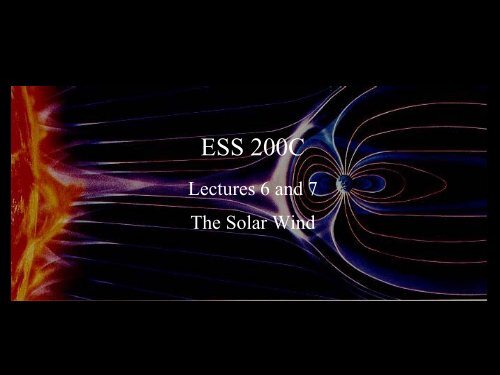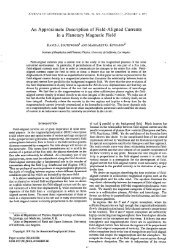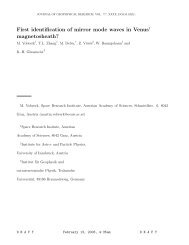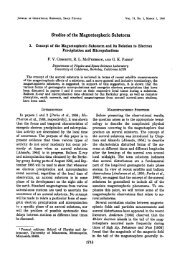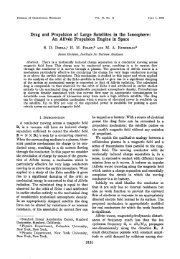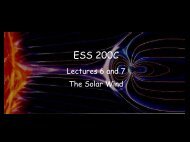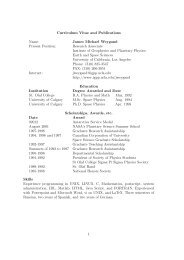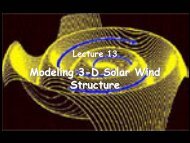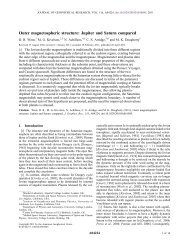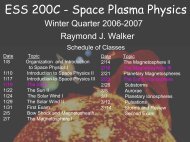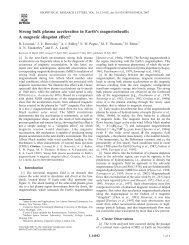The Solar Wind.pdf
The Solar Wind.pdf
The Solar Wind.pdf
You also want an ePaper? Increase the reach of your titles
YUMPU automatically turns print PDFs into web optimized ePapers that Google loves.
• <strong>The</strong> solar wind exists because the Sun maintains a2x10 6 K corona as its outer most atmosphere.• <strong>The</strong> Sun’s atmosphere “boils off” into space and isaccelerated to high velocities (> 400 km s -1 ).• Parker [1958] proposed that the solar wind was theresult of the high temperature corona anddeveloped a hydrodynamic model to support hisidea. Based on this Dessler developed a simplegravitational nozzle which demonstrates the basicphysics.– Simplifying assumptions:1. <strong>The</strong> solar wind can be treated as an ideal gas.2. <strong>The</strong> solar wind flows radially from the Sun.3. Acceleration due to electromagnetic fields is negligible.4. <strong>The</strong> solution is time stationary (i.e. the time scale forsolar wind changes is long compared to the time scalefor solar wind generation).
• <strong>The</strong> transition from subsonic to supersonic occurs at a criticalradius r c where v = c s• In order for a real continuous solution to exist at r cGMSunrc=22cs• <strong>The</strong> form of solutions for the expansion of the solar wind• Solution A is the “observed” solar wind. It starts as a subsonicflow in the lower corona and accelerates with increasing radius.At the critical point the solar wind becomes supersonic.• For solution F the speed increases only weakly with height andthe critical velocity is not reached. For this case the solar wind isa “solar breeze”.• For solution C the flow accelerates too fast, becomessupersonic before reaching the critical radius and turns aroundand flows into the Sun.
• Solution B starts as a supersonic flow in the lower corona andbecomes subsonic at the critical point.• If the flow decelerates less as in D it would still be supersonic atthe critical point and be accelerated again.• Solution E is an inward blowing wind that is subsonic. <strong>The</strong> flowaccelerates as it approaches the Sun, turns back and leaves theSun supersonically.• Quantitative solutions (after Parker [1958])
• For the solar wind to continue to accelerate then themean thermal energy must exceed the gravitationalenergy.• To have a solar wind a star must have a cool loweratmosphere and a hot outer atmosphere.• How is the corona heated?−γp ρ = const.cp– Assume an ideal gas where γ = = ration ofcvspecific heats.– If there is no heat gain or loss then the system is adiabatic5and γ =32 γ p– c s=ρGMSun 2– Taking the spatial derivative of > 2cswe findrd 20 > csrdrd γ −10 > ( rρ )dr
• Solvingρ ⎛> ⎜ρ ⎝0r0r⎞⎟⎠1γ −1Where ρ is the density at the base of the atmosphere r 0 .0• From the conservation of mass we getρ ⎛ r< ⎜ρ ⎝ r• <strong>The</strong>se two conditions cannot be solved for3and thereforethe lower atmosphere can’t be adiabatic.• Heat must be supplied from the cooler stellar surface!00⎞⎟⎠2γ =5
• Waves and turbulence?– One possibility is that the corona is heated by compressionalwaves at or just below the surface. Oscillatory motion of theSun’s surface could drive pressure waves. In theory fastmode waves could propagate up to 20R Sun . Experimentsdesigned to detect sound waves propagating into the coronahave not detected them.• Impulsive energy release?– <strong>The</strong> Sun has a magnetic field that contains magnetic energy.Magnetic energy can be converted into thermal energy. Thisis done by reconnection. <strong>The</strong> granularity of the photosphereas the top of the convection zone is caused by bubbles risingand falling. <strong>The</strong>se might reconnect. X-ray bursts may beevidence of this happening.• We still don’t know how the corona is heated!
• In summary the outer layer of the solar atmosphere willaccelerate outward provided a suitable heating source addsenough energy to overcome the Sun’s gravitational energy.• <strong>The</strong>re is a limit to how hot the atmosphere can be and still produce asupersonic solar wind!ρ kT2 dp kTp = nkT = cms= =d ρ m– For an ideal gas and where m is the massof the gas particles.– Using this the equation for the solar wind expansion becomes2kTGMSun−dv v= m rdr r 2 kTv −m– For very hot stars the numerator is always positive and the denominator isnegative so that as the atmosphere expands the velocity decreases andnever becomes supersonic.– For cool stars both numerator and denominator start negative and flowaccelerates outward. At some time v approaches the sonic velocity. At thispoint the acceleration will only continue if the thermal energy exceeds thegravitational energy.
• Intermixed with the outflowing solar wind is a weak magneticfield – the interplanetary magnetic field (IMF).– On the average the IMF is in the ecliptic plane at the orbit of the Earthalthough at times it can have substantial components perpendicular tothe ecliptic.– <strong>The</strong> hot coronal plasma has extremely high electrical conductivity andthe IMF becomes “frozen in” to the flow.– If the Sun did not rotate the resulting magnetic configuration would bevery simple: magnetic field lines stretching radially from the Sun..– As the Sun rotates (sidereal period 27 days) the base of the field linefrozen into the plasma rotates westward creating an Archimedeanspiral.
• Assume a plasma parcel on the Sun at a sourcelongitude of ϕ and a source radius of r 0 .0– At time t the parcel will be found at the positionand r( t)= v t + swr0ϕ −ϕ0– Eliminating the time gives r = vsw + r0ωSunϕ ( t)= ω t + ϕSun0
• Let us express the magnetic field in the equatorialrplane in polar coordinates as B = B , B )(r ϕ1 ∂ 2– Gauss’s Law in spherical coordinates is ∇ ⋅ B r = r2 r=r ∂rB2 2since the field depends only on r so that r B = .rr0B0– <strong>The</strong> magnetic flux through radial shells is conserved and the radialcomponent of the field decreases as2⎛ r0⎞B r= B0⎜⎟⎝⎠r r– <strong>The</strong> frozen-in field condition ∇×( v × B)= 0 gives1 ∂( r(vϕ Br− vrB ϕ)) = 0r ∂ror r( v B v B )) const.If we assume thatϕ r−r ϕ=get2rvϕ Br− rvrBϕ=BϕB=ϕrvϕv=Bϕr− r20rvr− rωvrr 0ω BB ω0Sun BrSunSun0B r( ) 0is radial at r 0we
ω > Sunv ϕϕSun r r– At large distances and B ≈ − rωB v .– <strong>The</strong> radial component falls off as r -2 while the azimuthal componentfalls off as r -1.2( B r)0 0 1 ⎛ω2⎟ ⎞SunrB r = +⎜r ⎝ vr⎠• <strong>The</strong> angle between the magnetic field direction and the radiusvector from the Sun is tanψ = B ϕB r. For typical solar windparameters at the Earth it is about 45 0 with respect to the radialdirection.• <strong>The</strong> stretched out heliospheric configuration is maintained by anequatorial current sheet. <strong>The</strong> magnetic field lines and currentlines are plotted below.
• <strong>The</strong> IMF can be directed either inward or outwardwith respect to the Sun.• One of the most remarkable observations from earlyspace exploration was that the magnetic field polaritywas uniform over large angular regions and thenabruptly changed polarity.– This polarity pattern repeated over succeeding solarrotations. <strong>The</strong> regions of one polarity are called magneticsectors.– In a stationary frame of reference the sectors rotate with theSun.– Typically there are about four sectors.– <strong>The</strong> sector structure gets very complicated during solarmaximum.
• <strong>The</strong> sector structure inferred from IMP satelliteobservations. Plus signs are away from the Sun andminus signs are toward the Sun.
• A meridian view of the IMF– <strong>The</strong> rotation and dipole axes arealong the left edge of the figureand the solar equator ishorizontal– <strong>The</strong> dipole component of thesolar magnetic field (dashedlines) is distorted by the solarwind flow– <strong>The</strong> expected IMF is shown bysolid lines.– Beyond a distance of about 2solar radii the solar wind isstronger than the tension in thefield lines and the field lines arepulled outward– <strong>The</strong> IMF that reaches the Earthhas its foot-points rooted atmiddle latitudes– <strong>The</strong> antiparallel field lines in theequatorial plane require acurrent sheet between them.
• That the IMF has sector structure suggests that plasma in agiven sector comes from a region on the Sun with similarmagnetic polarity.• <strong>The</strong> sector boundaries are an extension of the “neutral line”associated with the heliospheric current sheet (HCS).– <strong>The</strong> dipolar nature of the solar magnetic field adds latitudinalstructure to the IMF.– <strong>The</strong> radial magnetic field has one sign north of the HCS and onesign south of the HCS.– <strong>The</strong> current sheet is inclined by about 7 0 to the rotational equator.– As the Sun rotates the equator moves up and down with respect tothe solar equator so that the Earth crosses the equator twice arotation. [From Kallenrode, 1998].
• As the Sun rotates the three dimensional currentsheet becomes wavy. This is sometimes called theBallerina skirt model of the heliosphere.
• <strong>The</strong> solar wind speed and density have large variations ontime scales of days. Of special interest are high speedstreams.– <strong>The</strong> flow speed varies from pre-stream levels (400 km/s) reaching amaximum value (600 km/s – 700 km/s) in about one day.– <strong>The</strong> density rises to high values (>50 cm -3 ) near the leading edgesof the streams and these high densities generally persist for about aday. <strong>The</strong> peaks are followed by low densities lasting several days.– <strong>The</strong> proton temperature varies like the flow speed.– <strong>The</strong> high speed streams tend to have a dominant magnetic polarity.– <strong>The</strong> dominant source of high speed streams is thought to be fieldlines that are open to interplanetary space. <strong>The</strong>se regions areknown as coronal holes.
• Observations of high speed streams– Velocity, densityand protontemperature of twohigh speed streams– Speed andtemperature havesimilar variationswith time– Note that low speedcorresponds to highdensity and viseversaFlow Speed (km/s)Density (cm -3 )Temp. (K)250 7501 10 10010 4 10 5
• <strong>The</strong> Archimedean spiral associatedwith slow streams is curved morestrongly than for a fast stream.• Because field lines are not allowedto intersect at some point aninteraction region develops betweenfast and slow streams. Since bothrotate with the Sun these are calledcorotating interaction regions(CIR).• On the Sun there is an abruptchange in the solar wind speeds butin space the streams are spread out.• At the interface between fast andslow streams the plasma iscompressed.• <strong>The</strong> characteristic propagationspeeds (the Alfven speed and thesound speed) decrease.• At some distance between 2AU and3AU the density gradient on bothsides of the CIR becomes large anda pair of shocks develop.• <strong>The</strong> shock pair propagate awayfrom the interface.– <strong>The</strong> shock propagating into theslow speed stream is called aforward shock.– <strong>The</strong> shock propagating into thefast wind is called a reverseshock.
• Time series of parameters associated with a CIR– Between the two shock waves, andcentered on the interface, the plasma iscompressed– This implies a higher density of S’ plasmathan unshocked S plasma– Similarly the shocked F’ plasma is higherdensity than unshocked F plasma, but thedensity of F’ < density S’ since fast plasmahas lower density than slow plasma– <strong>The</strong> S’ plasma is moving faster than S, butslower than F’ which is slower still than F– <strong>The</strong> S’ plasma has a positive azimuthalvelocity, the interface a zero azimuthalvelocity, and the F’ a negative azimuthalvelocity– <strong>The</strong> magnitude of the magnetic field iscompressed between the shocks– <strong>The</strong>re is increased magnetic turbulenceand temperature in the interaction region– Not shown is a tipping of the IMF out of theecliptic plane
• Changes in the solar wind plasma parameters (speed V, density N,proton and electron temperatures TP and TE, magnetic-fieldintensity B, and plasma pressure P) during the passage of aninterplanetary shock pair past the ISEE 3 spacecraft. [Hundhausen,1995].
• Until the 1990’s our knowledge of the heliosphere was limited tothe ecliptic.• <strong>The</strong> Ulysses spacecraft observed the flow over both thenorthern and southern poles of the Sun.• No latitudinal gradient in B r .– Magnetic flux is removed from the poles toward the equatorialregions.– Sketch showing equatorial current sheet and magnetic field linescoming from the polar regions toward the equator. [Smith et al.,1978]
• Plasma measurementsshow a dramatic change invelocity with latitude inobservations takenbetween 1992 and 1997.[McComas et al., 1998].– <strong>The</strong> velocity increases fromabout 450 km/s at theequator to about 750 km/sabove the poles.– Above 50 0 only fast solarwinds streaming out ofcoronal holes were observed.– Up to about 30 0 a recurrentCIR was observed with aperiod of about 26 days.
• <strong>The</strong> heliospheric current sheet shows markedvariation during the solar cycle.– <strong>The</strong> “waviness” of the current sheet increases at solarmaximum.– <strong>The</strong> current sheet is rather flat during solar minimum butextends to high latitudes during solar maximum.– During solar minimum CIRs are confined to the equatorialregion but cover a wide range of latitudes during solarmaximum.– <strong>The</strong> average velocity of the solar wind is greater during solarminimum because high-speed streams are observed morefrequently and for longer times
• A coronal mass ejection in space– A time sequence of differencesbetween four images taken with the<strong>Solar</strong> Maximum Missioncoronagraph during a coronal massejection on 14 April 1980 and asingle "pre-event" image.– Positive differences (brightenings ofthe corona since the pre-eventimage) are shown in red andorange, negative differences inblue.– A pair of bright (red) loops movedoutward through the coronabetween 0544 and 0709 UT,leaving a wedge of depleted (blue)corona behind them (as at 0847UT).– Coronal features to the sides of theloops were progressively pushedaway from the ejection during itspassage through the coronagraphfield of view, and are thus visible onthese difference images
• Observations of a CME in space– CMEs are often referred to asmagnetic clouds, bottles, or flux ropes.At 1 AU they take about a day to passthe Earth.– <strong>The</strong> axis of these may have anyorientation. <strong>The</strong> simplest rope lies inthe ecliptic plane orthogonal to theEarth-Sun line– <strong>The</strong>ir identifying characteristic is aregion of nearly constant magneticfield strength with slow sinusoidalchanges in the two field angles. N isgenerally low.– If the cloud is traveling fast relative tothe solar wind a shock will form aheadof the cloud. <strong>The</strong> shock is evident fromthe increase in B, N, T (V T ), and V.<strong>The</strong>se are called InterplanetaryShocks (IPS).• In the sheath between the shock andcloud the field and density arecompressed and turbulent.
• <strong>The</strong> magnetic field configuration of a magnetic cloudcan be inferred from the variation in the elevation.– At the beginning of the event the field is perpendicular to theecliptic plane.– After the cloud has passed the field has almost reverseddirection.– This is an indication of a magnetic field wrapped around thestructure – sometimes called a flux rope.– Note the increasing helicity of the field from the inside out.– <strong>The</strong> orientation of the magnetic cloud (i.e. whether is it norththen south or vice versa depends on the field at the source).
• In some CMEs there areboth forward and reverseshock.– <strong>The</strong> forward shock forms in theslow solar wind speeding it uprelative to the Earth, but slowingthe flow as seen by the CME.– <strong>The</strong> reverse shock propagatesinto the magnetic cloud slowing itdown relative to the Earth.• <strong>The</strong> cloud may be rotated anany angle about the Earth-Sunline.• How long the cloud staysconnected to the Sun is notknown.• Magnetic clouds are the maincause of geomagneticdisturbances called magnetic
•<strong>The</strong> solar wind forms abubble, called the heliosphere,in the partially ionized localinterstellar medium (LISM).•We do not know if the LISM issubsonic – the LISM flow willbe diverted around theheliospheric obstacle eitheradiabatically or by forming abow shock.•<strong>The</strong> boundary separating theheliosphere from the LISM isthe heliopause (HP).•<strong>The</strong> solar wind is supersonicand a shock (the terminationshock-TS) forms within theheliosphere as it approachesthe heliopause.•<strong>The</strong> region of shockedplasma between the TS andthe heliopause is called theinner heliosheath.•In the simulation below theLISM flow was assumed tobe supersonic and nointerstellar neutral hydrogenwas assumed.Contours of temperature andflow streamlines- from Zank etal., 2001
• Observations from Voyager 1 as it crossed thetermination shock.– (left) Energetic particle measurements show increase inparticle fluxes at shock (A, B, D) and change is first orderanisotropies (C) and radial velocity (F). (Decker et al., 2005)–(right) <strong>The</strong> magnetic field magnitude increased (A) and thegalactic cosmic ray intensity increased. (Burlaga et al., 2005)
• <strong>The</strong> Voyager passage through the termination shock– Voyager was 94AU from the Sun when it encountered theshock.–<strong>The</strong> shock was moving toward the Sun possibly becausedecreasing solar wind dynamic pressure.– As of December, 2005 Voyager 1 was still in the heliosheath.


